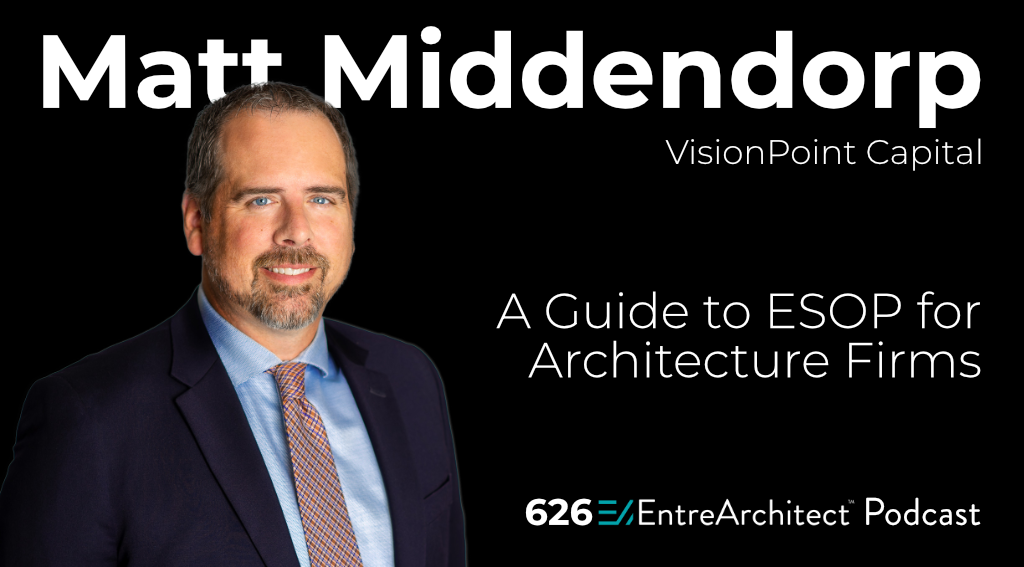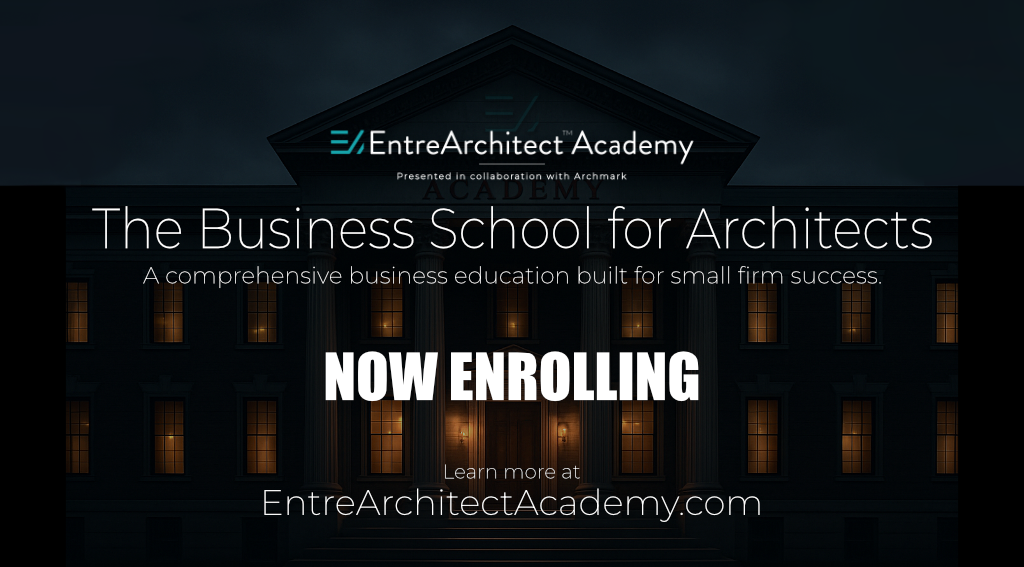
Why ESOPs Matter for Architects
When small firm architects talk about succession, legacy, and culture, Employee Stock Ownership Plans (ESOPs) often come up. They promise a way to reward the people who built the firm, provide liquidity for the owner, and preserve the practice for the future. But what exactly is an ESOP, and how do you know if it’s the right path?
In Episode 626 of the EntreArchitect Podcast, I sat down with Matt Middendorp of VisionPoint Capital, an ESOP consultant who has lived through the process himself. Our conversation debunked the myths, revealed the opportunities, and explored practical steps that every architect should understand before considering this option.
What is an ESOP?
At its core, an ESOP is three things:
- A business transition tool that gives owners liquidity while strengthening the company.
- An employee ownership vehicle that aligns the financial success of the firm with its people.
- A qualified retirement plan, similar to a 401(k), but funded entirely by the company, not the employees.
That combination makes it uniquely powerful for architecture firms that care deeply about culture, continuity, and people.
How ESOPs Work in Practice
When an ESOP is established, a trust is created to purchase the company from the owner. A third-party trustee oversees the transaction, but leadership of the firm remains with management. That’s the key difference from most mergers or acquisitions: you don’t lose control of the firm you built.
Employees don’t buy shares with their own money. Instead, over time they accrue ownership through allocations in the ESOP trust. They become beneficial owners, which means they gain financial benefit without the burden of direct governance.
Funding and Payouts for Owners
Most ESOPs are funded through a mix of bank loans and seller financing. The seller is typically paid out over time, often earning above-market interest on the balance. For owners used to thinking that private equity or third-party sales guarantee a lump-sum payday, it’s important to note: those deals often stretch payments out too. ESOPs simply acknowledge it upfront.
The Wealth-Building Advantage for Employees
ESOPs give architects and staff members something rare in our profession: the ability to build real long-term wealth through ownership. Shares are allocated gradually, typically with vesting schedules like a 401(k). Over years, these balances can grow significantly, creating financial security that many employees in traditional firms never achieve.
The Pullover Moment: Tax Benefits
Here’s the moment Matt always warns listeners about. If your firm is an S corporation and 100% owned by the ESOP, the company no longer pays federal income taxes and, in most states, no state income taxes either. Even partial ESOP ownership provides proportional tax relief.
That means the dollars you would have sent to the IRS can now fund growth, stability, and investment in your team.
Is an ESOP the Right Fit for Your Firm?
ESOPs are not for every architecture practice. They work best for profitable, US-based firms with at least 15 to 25 employees. Smaller firms sometimes qualify, but compliance testing can make the structure difficult.
More than size, though, culture is critical. Successful ESOP firms are transparent, communicative, and willing to teach employees how their decisions affect business outcomes. If you want ownership thinking but hesitate to share financial context, this model may not be a fit.
What to Expect After Transition
ESOP-owned firms often see productivity gains, faster growth, and higher returns compared to their peers. But this doesn’t happen automatically. Owners must cultivate the culture by explaining valuation changes, celebrating share price increases, and linking daily decisions to long-term wealth creation.
Timeline and Costs
The ESOP journey unfolds in phases:
- Phase One: Education and Feasibility Study (4–6 weeks). This answers whether the owner, company, and employees all benefit.
- Phase Two: Transaction (4–6 months). The trustee is hired, the ESOP plan is designed, and the sale closes.
- Phase Three: Ownership Culture. The firm celebrates the transition, teaches employees what ownership means, and builds habits around transparency.
Valuation and Fair Market Value
Unlike private equity negotiations that often focus on knocking down value, ESOP trustees are bound to buy at fair market value. They assess future cash flows, corroborated by past performance and reasonable projections. The process is collaborative, not combative.
Avoiding Common Pitfalls
Mistakes often happen when firms treat ESOPs like a paperwork project. The most dangerous include:
- Using a generalist attorney instead of specialized counsel.
- Failing to plan for future repurchase obligations.
- Allocating too many shares too soon.
- Neglecting the ongoing culture work that makes employee ownership real.
The Emotional Side for Owners
Selling your firm, even to your employees, is an emotional decision. Matt described it as harder than choosing a college or even getting married. An ESOP respects that reality. You don’t have to walk away immediately. You can stay involved, continue leading, and gradually transition while building wealth for yourself and your team.
How to Begin
Start with education. A feasibility study is the low-risk first step that reveals what the transaction would look like for you, your company, and your employees. From there, you can make an informed decision—whether that means moving forward now or preparing for later.
A Final Word to Small Firm Architects
ESOPs are not just about succession. They’re about creating alignment, rewarding people, and building resilience into your practice. For the right firm, they offer a powerful way to balance legacy, liquidity, and culture.
Go Deeper
This article is just a starting point. To hear stories, examples, and the details behind each step, listen to Episode 626 of the EntreArchitect Podcast with Matt Middendorp at https://entrearchitect.com/626.

Leave a Reply